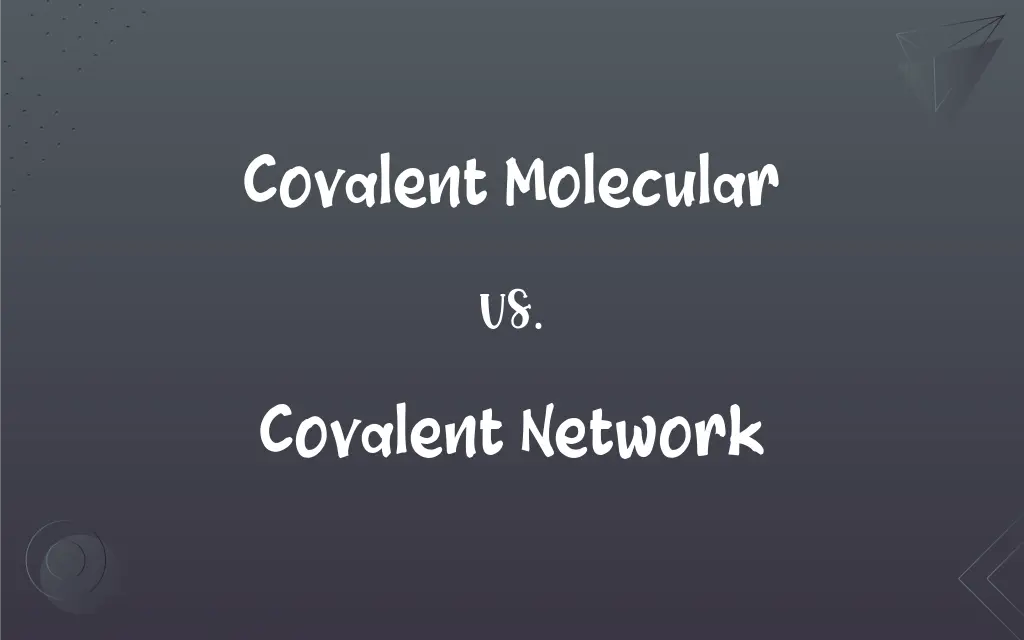Covalent Molecular vs. Covalent Network: What's the Difference?
Edited by Harlon Moss || By Janet White || Published on December 27, 2023
Covalent molecular compounds consist of molecules held together by covalent bonds, whereas covalent network compounds form extended networks of covalently bonded atoms.

Key Differences
Covalent molecular compounds are formed by individual molecules linked by covalent bonds, with distinct molecular units. Covalent network compounds, on the other hand, consist of a continuous network of covalent bonds extending throughout the material.
Covalent molecular compounds typically have lower melting and boiling points due to weaker intermolecular forces, whereas covalent network compounds often have high melting and boiling points due to the strength of the covalent network.
Covalent molecular compounds are generally non-conductive and vary in solubility, while covalent network compounds are typically insoluble in most solvents and are non-conductive, with some exceptions like graphite.
Common examples of covalent molecular compounds include water (H2O) and carbon dioxide (CO2). Examples of covalent network compounds include diamond and silicon carbide (SiC).
Covalent molecular compounds are widely used in various applications due to their diverse chemical properties, while covalent network compounds are valued in industries for their strength and thermal stability.
ADVERTISEMENT
Comparison Chart
Basic Unit
Individual molecules
Continuous network of atoms
Melting/Boiling Point
Generally lower
Generally higher
Electrical Conductivity
Non-conductive (usually)
Non-conductive (with exceptions)
Solubility
Variable, depending on compound
Generally insoluble
Typical Uses
Diverse, including in daily life
Industrial, high-strength materials
ADVERTISEMENT
Covalent Molecular and Covalent Network Definitions
Covalent Molecular
Covalent molecular compounds have lower melting and boiling points.
Methane, a covalent molecular compound, has a low boiling point of -161.5 °C.
Covalent Network
Covalent network compounds are solids with atoms interconnected by covalent bonds in a continuous network.
Diamond is a covalent network compound with each carbon atom tetrahedrally bonded to four others.
Covalent Molecular
Covalent molecular substances often exist as gases, liquids, or low melting point solids.
Ammonia, a covalent molecular gas, is used widely in industry.
Covalent Network
Covalent network compounds are generally hard and strong.
Quartz, consisting of a covalent network of silicon and oxygen, is extremely hard.
Covalent Molecular
Covalent molecular compounds can be polar or nonpolar.
Hydrogen chloride is a polar covalent molecular compound.
Covalent Network
Covalent network compounds are typically insoluble in most solvents.
Graphene, a single layer of carbon atoms in a covalent network, is insoluble in water.
Covalent Molecular
Covalent molecular compounds are composed of molecules bonded covalently.
Water is a covalent molecular compound with two hydrogen atoms covalently bonded to an oxygen atom.
Covalent Network
Some covalent network compounds can conduct electricity.
Graphite, a covalent network compound, conducts electricity due to its delocalized electrons.
Covalent Molecular
Covalent molecular substances have distinct molecular units.
Carbon dioxide, a covalent molecular compound, consists of discrete CO2 molecules.
Covalent Network
Covalent network structures have very high melting and boiling points.
Silicon carbide, a covalent network compound, is known for its high thermal stability.
FAQs
Are covalent molecular compounds typically solid?
They can be solid, liquid, or gas, often with lower melting points.
What defines a covalent molecular compound?
Covalent molecular compounds consist of molecules bonded by covalent bonds.
Can covalent molecular compounds conduct electricity?
Generally, they are non-conductive.
Are covalent network compounds conductive?
They are usually non-conductive, but some, like graphite, can conduct electricity.
Give an example of a covalent network compound.
Diamond, made entirely of carbon, is a covalent network compound.
What is a covalent network compound?
Covalent network compounds are solids with a continuous network of covalently bonded atoms.
How are covalent molecular compounds used in daily life?
They are prevalent in various forms, from water to organic compounds.
Do covalent network compounds have high melting points?
Yes, they generally have very high melting points.
What is an example of a covalent molecular compound?
Water (H2O) is a common example.
Are covalent molecular compounds soluble in water?
Their solubility varies; some are soluble, others are not.
Are all covalent network compounds hard and brittle?
Most are hard, but their brittleness can vary.
Are covalent network compounds thermally stable?
Yes, they are known for their high thermal stability.
What are the industrial uses of covalent network compounds?
They are used in high-strength materials and electronics.
Do covalent molecular compounds have distinct molecular units?
Yes, they consist of discrete molecular units.
What's the state of matter for covalent molecular compounds at room temperature?
They can be solid, liquid, or gas at room temperature.
What's the chemical variability of covalent network compounds?
They are less chemically diverse compared to covalent molecular compounds.
Can covalent molecular compounds be gases?
Yes, many exist as gases, like nitrogen and oxygen.
Can covalent molecular compounds form crystals?
Some can form molecular crystals with weak intermolecular forces.
Is solubility a feature of covalent network compounds?
They are generally insoluble in most solvents.
Is the covalent network structure continuous?
Yes, it's a continuous network of bonded atoms.
About Author
Written by
Janet WhiteJanet White has been an esteemed writer and blogger for Difference Wiki. Holding a Master's degree in Science and Medical Journalism from the prestigious Boston University, she has consistently demonstrated her expertise and passion for her field. When she's not immersed in her work, Janet relishes her time exercising, delving into a good book, and cherishing moments with friends and family.
Edited by
Harlon MossHarlon is a seasoned quality moderator and accomplished content writer for Difference Wiki. An alumnus of the prestigious University of California, he earned his degree in Computer Science. Leveraging his academic background, Harlon brings a meticulous and informed perspective to his work, ensuring content accuracy and excellence.































































